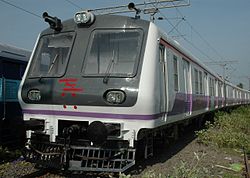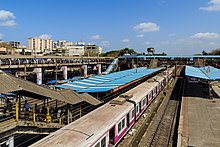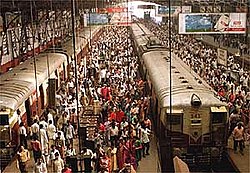The Western line of the Mumbai Suburban Railway is a public transit system serving Mumbai Metropolitan Region, Maharashtra. It consists of 37 stations from Dahanu Road to Churchgate railway station. It is operated by Western Railways (WR). The entire line is at grade.
Trains are differentiated as slow and fast locals. Slow trains stop at all stations, while fast ones stop at main stations only and are preferable over longer distances. Trains usually start from and terminate at main stations. The section from Churchgate to Virar is a Quadruple track. An EMU car shed has been built between Nalla Sopara and Virar which is the largest car shed in Asia. A repair shop for EMUs is situated at Mahalaxmi. There are also EMU car sheds at Mumbai Central and Kandivali.
History
[edit]
Suburban service on what is now the Western line was offered by the Bombay, Baroda and Central India Railway, which began running steam trains in 1867.[2] Rakes operating on DC electricity were introduced on 5 January 1928. Leslie Wilson (politician), the then-Governor of Bombay inaugurated the line running between Colaba and Borivali at Mahalaxmi, in the presence of 700 invitees.[3]
The proposal to ply Electric Multiple Unit (EMU) trains between Dahanu and Churchgate was approved in the 2012–13 Railway Budget. In March 2013, 18 MEMU services ran between Virar and Dahanu daily.[4][5]
On 16 April 2013, the 160th anniversary of the Indian Railways,[6] Railway Minister Pawan Kumar Bansal inaugurated the first EMU service between Churchgate and Dahanu Road.[7][8] The first Churchgate-Dahanu local was flagged off around 10:47am and arrived at Churchgate at 1:44pm. Prior to the launch of this service, EMU services on WR only ran on the 60 km stretch between Churchgate and Virar.[9][10]
The Western Line transported 127.94 crore passengers (1.28 billion) in the 2016-17 fiscal year. This is higher than the population of India according to the 2011 Census, which was recorded as 121.01 crores. During the same period, Western Railway sold 270.3 million tickets and 13.7 million season passes, earning a total revenue of ₹818.48 crore (US$98 million) from its suburban rail operations.[11]
Timeline
[edit]- 12 April 1887: The BB&CI Railway commences daily service between Virar and Backbay
- 1870: Churchgate station opened
- 1873: Colaba Terminus commissioned
- 5 January 1928: First electric train runs between Colaba & Borivili
- 1930: Colaba station closed
- 1936: Steam engines are withdrawn from service; Borivili–Virar section electrified[3]
- 2 March 1961: Introduction of 9-car trains
- 1972: Total number of services crosses the 500 mark
- 1986: Introduction of 12-car trains
- 1992: Introduction of special trains for ladies and reserved seating for seniors
- 1993: Introduction of special handicapped compartment
- 2003: Total number of services crosses the 1,000 mark
- 2007: Indian Railways' first ATVMs introduced on WR; DC-AC conversion of Borivili–Virar section completed[3]
- 21 November 2009 : Introduction of 15-car rakes
- November 2011: DC-AC conversion of Borivili–Vile Parle section complete[3]
- 5 February 2012 : Conversion from DC to AC traction completed
- 16 April 2013 : Extension of line from Virar to Dahanu Road
- 27 November 2016 : 37th station, Ram Mandir railway station at Oshiwara was opened between Goregaon and Jogeshwari station.
- 25 December 2017 : The first air-conditioned suburban train service in India began at 10:32 AM departing from Borivali to Churchgate.[12][13]
Stations
[edit]


(Names in bold indicate that the station is a fast train stop.)
| Western line | ||||
|---|---|---|---|---|
| # | Station Name | Station Code | Connections | |
| English | Marathi | |||
| 1 | Churchgate | चर्चगेट | C/CCG | Metro Line 3 |
| 2 | Marine Lines‡ | मरीन लाइन्स | MEL | None |
| 3 | Charni Road‡ | चर्नी रोड | CYR | None |
| 4 | Grant Road‡ | ग्रँट रोड | GTR | Metro Line 3 |
| 5 | Mumbai Central | मुंबई सेंट्रल | BCL | Indian Railways and Metro Line 3 |
| 6 | Mahalaxmi | महालक्ष्मी | MX | Metro Line 3 and Monorail Line 1 |
| 7 | Lower Parel | लोअर परळ | PL | None |
| 8 | Prabhadevi | प्रभादेवी | PBHD | Parel† (Central line) |
| 9 | Dadar | दादर | D/DDR | Indian Railways and Central line |
| 10 | Matunga Road | माटुंगा रोड | MRU | None |
| 11 | Mahim Junction | माहिम जंक्शन | MM | Harbour line |
| 12 | Bandra | वांद्रे | B/BA | Harbour line and Metro Line 2 |
| 13 | Khar Road | खार रोड | KHAR | Harbour line |
| 14 | Santacruz | सांताक्रुझ | STC | Harbour line |
| 15 | Vile Parle | विलेपार्ले | VLP | Harbour line |
| 16 | Andheri | अंधेरी | AD/ADH | Indian Railways, Harbour line and Metro Line 1 |
| 17 | Jogeshwari | जोगेश्वरी | JOS | Harbour line and Metro Line 6 |
| 18 | Ram Mandir | राम मंदिर | RMAR | Harbour line |
| 19 | Goregaon | गोरेगाव | G/GMN | Harbour line |
| 20 | Malad | मालाड | MDD | None |
| 21 | Kandivli | कांदिवली | KILE | None |
| 22 | Borivali | बोरीवली | BO/BVI | Indian Railways |
| 23 | Dahisar | दहिसर | DIC | None |
| 24 | Mira Road | मीरा रोड | MIRA | None |
| 25 | Bhayandar | भाईंदर | BY/BYR | Indian Railways |
| 26 | Naigaon | नायगाव | NG/NIG | None |
| 27 | Vasai Road | वसई रोड | BS/BSR | Indian Railways and Central line |
| 28 | Nallasopara | नालासोपारा | NS/NSP | None |
| 29 | Virar | विरार | V/VR | Indian Railways |
| 30 | Vaitarna | वैतरणा | VTN | None |
| 31 | Saphale | सफाळे | SAH | None |
| 32 | Kelve Road | केळवे रोड | KLV | None |
| 33 | Palghar | पालघर | PLG | None |
| 34 | Umroli | उमरोळी | UOI | None |
| 35 | Boisar | बोईसर | BOR | None |
| 36 | Vangaon | वाणगाव | VGN | None |
| 37 | Dahanu Road | डहाणू रोड | DRD | None |
‡ indicates the stations which Fast Up trains (to Churchgate) skip from around 5PM to 8PM.[14]
†A footbridge links Prabhadevi to Parel on the Central line.
Churchgate railway station is the terminus station at the south end of Mumbai city. In Mumbai, Western Line (WR) suburban trains use this station as terminus. Long-distance trains and goods trains terminate at Mumbai Central railway station instead.
Above list of stations is mentioned from south end going towards northern suburban areas falling on WR corridor.

Electrification
[edit]
Western Railway's EMU fleet consists of EMUs running on AC 25 kV power. WR uses seven 9-car rakes.
The Western line began running electric trains with DC power on 5 January 1928.[15]
On 5 February 2012, WR finished converting the entire Western line from the earlier used 1,500 V DC to 25 kV AC power. The entire power conversion project cost about ₹500 crore. Since 25 kV AC power is 17 times stronger than DC, people riding on top of the trains will be killed if they come into contact with the overhead wires.[16]
The project was also expected to improve the punctuality of train services, make them energy-efficient and allow a greater number of 12-coach and 15-coach trains to ply. Post-conversion, local trains will be able to achieve speeds of 100 km/h with ease. The next step would be to convert the remaining 9-coach trains to 12-coach ones, thus augmenting the carrying capacity by 33%.[17] The system will need less maintenance.[18]
While using DC traction, 22 substations provided power to suburban trains on the Western line. Since switching over to AC traction, substations at Mahalaxmi, Bandra, Jogeshwari, Borivli and Vasai supply 25 kV power to local trains.[19]
Services
[edit]As of 27 March 2012, the Western line has approximately 1,290 local services running which carry about 3.55 million commuters every day.[20] These 1290 local services are operated using 80 trains.[21] Western Railways' EMUs are in 12 car and 15 car formations.[22]
The first 9-car service on the Western line ran on 2 March 1961. The 9-car service has since been phased out and the last service ran on the Western line on 20 November 2012.[23] However, 10 services (six on CR and four on WR) were still operated as 9-car even after that date as the track is shared by the Western line and the Harbour line. Harbour line platforms are too short to accommodate longer trains.[24]
In 2010, 15 car services between Churchgate and Virar were introduced.[25] They halt at all the stations between Borivli and Virar, and do not halt at any stations between Churchgate and Dadar. 15-coach trains are used in non-peak hours. They cannot be used in peak hours because the station platforms are too narrow to handle the increased foot traffic.[26]
| No. of coaches | No. of Services |
|---|---|
| Harbour Locals | 110 |
| 12 | 1,150 |
| 15 | 30 |
| Total | 1,290[27] |
Historical
[edit]The following table shows the number of services and daily ridership on the Western line throughout its history.[28]
| Year | No. of Services | Daily Ridership |
|---|---|---|
| 1867 | 6 | No data |
| 1990–91 | 866 | 2.3 million |
| 1991–92 | 900 | 2.5 million |
| 2000–01 | 961 | 2.82 million |
| 16 April 2013 | 1305 | 3.6 million |
Facilities
[edit]Escalators
[edit]WR has escalators at 26 stations including some main stations like Borivali, Andheri, Dadar, Vasai Road and Virar for the common people. This helps the physically challenged and senior citizens.
FOBs and Subways
[edit]As of 29 April 2013, there are 102 foot over bridges (FOB)[29] and 8 subways on the Western line.[30]
Train Management System
[edit]The Train Management System (TMS) is used by both staff and passengers to monitor the location of trains. TMS enables commuters to know what trains will be arriving in the next 10 minutes. The system was implemented on the Western line in 2004.[31]
Wi-Fi Facility
[edit]Free Wi-Fi facility from the Indian Railways (RailWire) is provided at some stations of the Western Line like Churchgate, Mumbai Central, Dadar, Bandra, Khar Road, Andheri, Borivali, Bhayander, Vasai Road and Virar.
Fatalities
[edit]In 2011, 1,313 commuters died in accidents on the Western line, mainly via trespassing on ten particular stretches of track. Since mid-February 2012, Railway Protection Force (RPF) personnel patrol the areas from 7am-11am and 5pm-10pm, the peak times for such incidents. Initially, they used posters in an education campaign and only cautioned offenders. They later escalated to arresting people.[32]
See also
[edit]- Western Railway Elevated Corridor
- Mumbai Suburban Railway
- List of Mumbai Suburban Railway stations
- Western Railways
References
[edit]- ^ "Is Mumbai Local Losing Popularity? Report Shows 20% Decline in Daily Commuters Using Suburban Trains". News18. 15 April 2023. Retrieved 30 September 2023.
- ^ WR brings Dahanu closer to city today – Times Of India. Retrieved on 2013-07-16.
- ^ a b c d Citizens inconvenienced by Western Railway mega block Archived 6 February 2012 at the Wayback Machine. Articles.timesofindia.indiatimes.com (2012-02-06). Retrieved on 2015-01-17.
- ^ Churchgate-Dahanu train by month-end – Times Of India. Articles.timesofindia.indiatimes.com (2013-03-19). Retrieved on 2013-07-16.
- ^ Churchgate-Dahanu trial run a success: WR – Mumbai – DNA Archived 21 March 2013 at the Wayback Machine. Dnaindia.com. Retrieved on 2013-07-16.
- ^ Churchgate-Dahanu local all set to roll from Tuesday – Mumbai – DNA Archived 19 April 2013 at the Wayback Machine. Dnaindia.com (2013-04-15). Retrieved on 2013-07-16.
- ^ Bansal launches train services on Dahanu-Churchgat Archived 19 April 2013 at the Wayback Machine. Zeenews.india.com (2013-04-16). Retrieved on 2013-07-16.
- ^ Western Railway Archived 21 April 2013 at the Wayback Machine. Wr.indianrailways.gov.in. Retrieved on 2013-07-16.
- ^ Dahanu-Churchgate local flagged off, enjoy seamless travel – Mumbai – DNA Archived 20 April 2013 at the Wayback Machine. Dnaindia.com. Retrieved on 2013-07-16.
- ^ "HC raps Western Railway for delay in service to Dahanu – The Times of India". The Times Of India. Archived from the original on 23 March 2018.
- ^ "Andheri remains WR's busiest station, accounts for 9% of tickets sold". Daily News & Analysis. 8 April 2017. Archived from the original on 9 April 2017. Retrieved 9 April 2017.
- ^ "First AC local train starts in Mumbai on the Borivali Churchgate route". Livemint. 25 December 2017. Retrieved 14 January 2019.
- ^ "Mumbai's AC local train: timings, fare and how to buy tickets". Conde Nast Traveller. 24 October 2018. Retrieved 14 January 2019.
- ^ Timetable of the Western line between 5PM and 8PM Archived 28 January 2015 at the Wayback Machine
- ^ "Direct current local to chug into sunset on Feb 4". Daily News and Analysis. 2 February 2012. Archived from the original on 16 September 2014. Retrieved 16 September 2014.
- ^ "Citizens inconvenienced by Western Railway mega block – The Times of India". The Times Of India. Archived from the original on 6 February 2012.
- ^ Mumbai: 25,000 volts to 'shock' rooftop travellers – India – IBNLive Archived 1 February 2012 at the Wayback Machine
- ^ "Western Railway sets stage for AC system – The Times of India". The Times Of India. Archived from the original on 5 February 2012.
- ^ "Western Railway claims overcrowding has reduced". The Times of India. Archived from the original on 11 April 2013.
- ^ "Western Railway plans 36 more services from Tuesday – The Times of India". The Times Of India. Archived from the original on 23 March 2018.
- ^ WR commuters complain of poor ventilation – Hindustan Times
- ^ Western Railway Archived 13 February 2015 at the Wayback Machine. Wr.indianrailways.gov.in (2013-03-29). Retrieved on 2013-07-16.
- ^ "From today, no 9-car trains in Western Railway suburban section". The Indian Express. 21 November 2012. Archived from the original on 30 November 2012. Retrieved 22 November 2012.
- ^ "By January 2013, Western Railway to roll out 55 new services". The Times of India. 21 November 2012. Archived from the original on 3 January 2013. Retrieved 22 November 2012.
- ^ city anchor: Central Railway starts 16 new services on main line – Indian Express
- ^ Nair, Binoo (23 January 2012). "CR still in two minds over 15-car trains". Mumbai Mirror. Archived from the original on 16 September 2014. Retrieved 16 September 2014.
- ^ "Services". Archived from the original on 13 February 2015.
- ^ WR brings Dahanu closer to city today – Times Of India. Articles.timesofindia.indiatimes.com (2013-04-16). Retrieved on 2013-07-16.
- ^ ​By June, escalators on 3 Western Railway stations – Times Of India. Articles.timesofindia.indiatimes.com (2013-04-29). Retrieved on 2013-07-16.
- ^ WR opens two FOBs at Charni Road, Andheri – Hindustan Times
- ^ Mehta, Manthan K (26 July 2012). "Real-time tracking till Kalyan". The Times Of India.
- ^ "Minor drop in deaths on tracks of Western Railways – The Times of India". The Times Of India. Archived from the original on 8 January 2018.
Mumbai topics | |||||||
|---|---|---|---|---|---|---|---|
| History | |||||||
| Geography | |||||||
| Buildings |
| ||||||
| Transport |
| ||||||
| Roads |
| ||||||
| Economy | |||||||
| Education and research |
| ||||||
| Civic | |||||||
| Culture | |||||||
| Religion | |||||||
| Other topics | |||||||
Railways in Western India | |
|---|---|
| National network / trunk lines | |
| Branch lines / sections |
|
| Suburban lines |
|
| Metro rail | |
| Monorail |
|
| Defunct lines revived / under revival | |
| Defunct lines | |
| Railway divisions | |
| Railway companies | |
| See also |
|